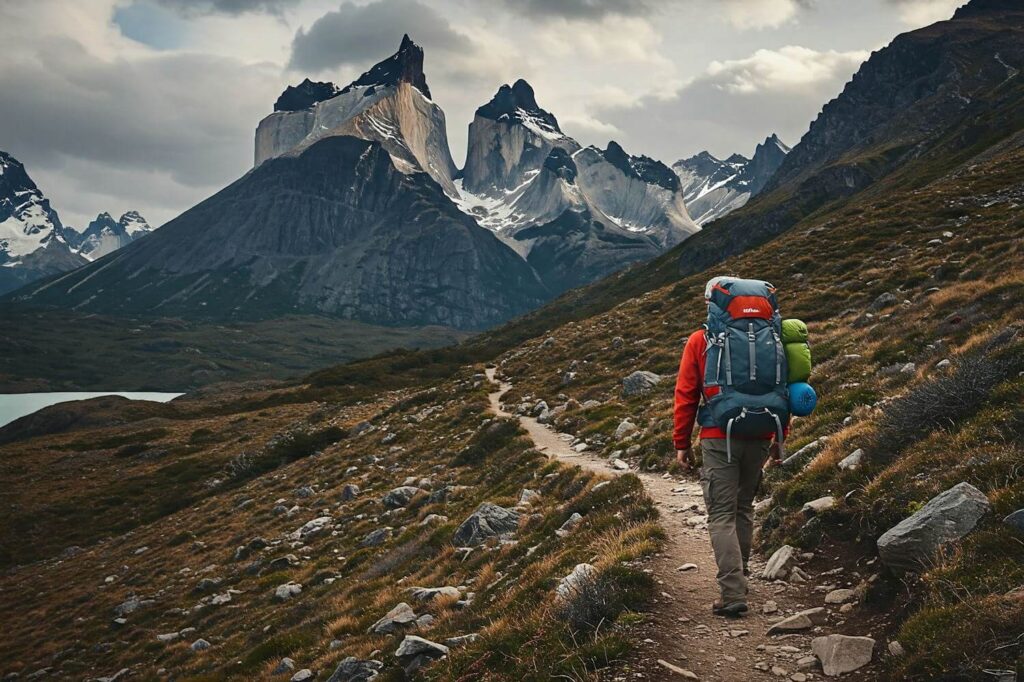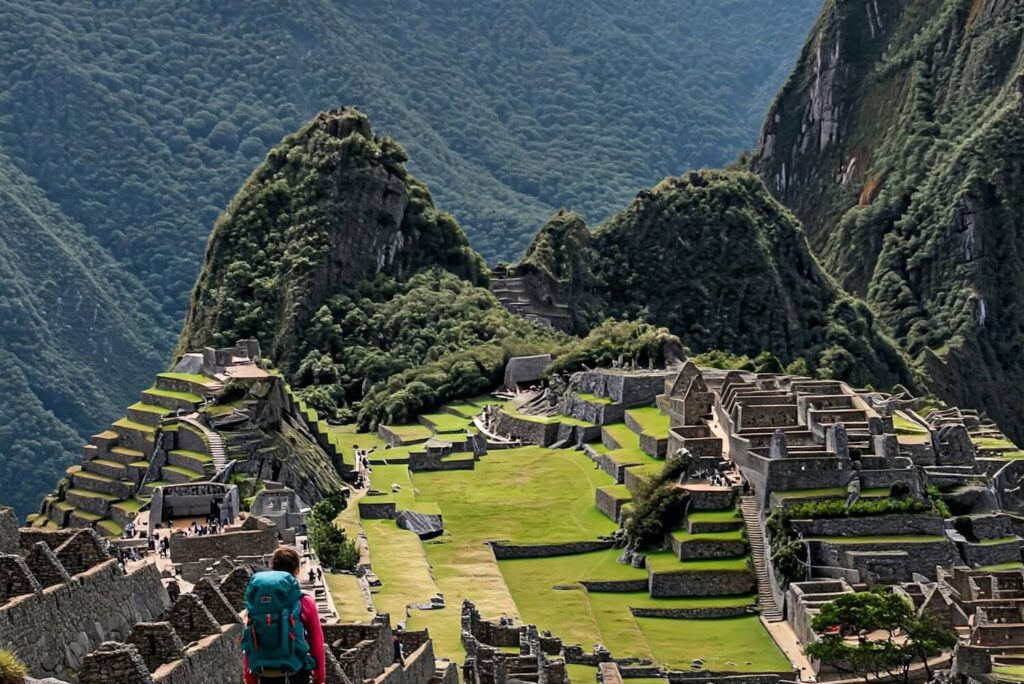Introduction to Patagonia and Torres del Paine
Patagonia, a region located at the southern end of South America, is renowned for its breathtaking landscapes and unrivaled natural beauty. Stretching across both Chile and Argentina, this geographical marvel is characterized by its dramatic mountains, vast plains, lush forests, and pristine lakes. Among its many treasures, Torres del Paine National Park stands out as a premier destination for backpackers and adventure enthusiasts alike. Covering over 242,000 acres, the park is distinguished by its iconic granite peaks, including the famous “Torres” or towers that give the park its name, as well as the towering Cuernos del Paine.
The unique ecosystem found within Torres del Paine is home to a diverse range of flora and fauna, including guanacos, condors, and the elusive puma. Its varied climatic conditions, from arid steppe to glacial valleys, foster an array of habitats that appeal to nature lovers and wildlife observers. The park’s intricate network of trails provides countless opportunities for exploration, allowing visitors to hike through lush valleys, navigate past turquoise lakes, and experience stunning views of the majestic glaciers. Backpacking in Torres del Paine offers not only outdoor adventure but also a chance to witness the area’s rich biodiversity up close.
There are numerous compelling reasons to choose Torres del Paine as a top backpacking destination. The park offers extensive trekking routes like the famous W and O circuits, which cater to various skill levels and preferences. Whether one seeks a challenging expedition or a more leisurely hike, Torres del Paine has something for everyone. Furthermore, the park’s landscapes are ever-changing, providing each visitor with a unique experience filled with awe-inspiring views. In summary, for anyone looking to immerse themselves in a captivating natural environment, Torres del Paine National Park in Patagonia is an ideal destination that promises adventure and unforgettable memories.
Planning Your Trip to Torres del Paine
Embarking on a journey to Torres del Paine National Park requires careful planning to ensure a rewarding and enjoyable experience. The best time to visit the park typically spans from late October to early April, coinciding with the Southern Hemisphere summer when temperatures are milder and days are longer. However, it is essential to note that weather conditions can be unpredictable and may vary significantly within a single day. Hence, flexibility in your plans is advisable.
To reach Torres del Paine, most travelers begin their journey in Punta Arenas or Puerto Natales, both of which offer various transport options, including buses and shuttles that provide direct routes to the park entrance. It is beneficial to book these transport services in advance, especially during peak season to secure your travel arrangements.
Permits are typically required for certain trails within the park, particularly for multi-day treks like the renowned W and O circuits. It is crucial to obtain these permits beforehand, as they limit the number of visitors in order to preserve the park’s natural beauty and ecosystem. Information on these permits can be easily accessed through the official Torres del Paine National Park website, which also provides insights into trail conditions and closures.
Accommodation options within the park range from campgrounds to luxurious lodges, suited to various budgets and preferences. Camping is a popular choice for backpackers, allowing for a more immersive experience with nature. When packing for your adventure, consider the diverse weather – layering is essential, and including waterproof and windproof clothing, as well as sturdy footwear, is highly recommended. Additionally, gear such as a reliable backpack, water purification system, and trekking poles can significantly enhance your overall hiking experience. Proper preparation will ensure your journey through Patagonia is as fulfilling as possible.
Must-See Attractions and Trails
Torres del Paine National Park, renowned for its dramatic landscapes, offers a multitude of attractions that are essential for any backpacking itinerary. One of the park’s most iconic features is the Torres del Paine, a trio of granite peaks that rise majestically from the Patagonian steppe. These towers provide a breathtaking backdrop for photographs and a rewarding hiking experience, as they can be accessed via various trails within the park. The most popular route to view these peaks is the W Trek, which showcases their grandeur while meandering through the diverse ecosystems of the area.
Another striking feature of the park is the Cuernos del Paine, a mountain range characterized by pointed granite summits. The peaks are distinctively colored, adding vibrancy to the landscape and making the area a rewarding spot for hiking and photography. The O Circuit, a longer trek encompassing the W Trek, leads adventurers around the Cuernos, providing a 360-degree view of these majestic formations along with an immersive experience of Torres del Paine’s natural beauty.
Grey Glacier, located in the western region of the park, is also a must-see. This expansive glacier offers visitors the opportunity to witness the striking blue hues of its ice formations. The trails surrounding Grey Glacier are well-marked, allowing for both short day hikes and longer treks that include outstanding vistas of the glacier and the surrounding mountains. Tailoring your visit to include these attractions will enrich your experience in the park significantly, providing a diverse mix of challenging hikes and captivating views.
Visitors should consider their fitness levels when choosing between trails. The W Trek, spanning approximately 75 kilometers, is moderately challenging, generally taking about four to five days to complete. In contrast, the O Circuit is demanding and extends up to 110 kilometers, requiring around eight to ten days. Regardless of the chosen adventure, the trails within Torres del Paine will leave a lasting impression with their stunning landscapes and remarkable natural wonders.
Wildlife and Natural Diversity
Torres del Paine National Park is renowned not only for its striking landscapes but also for its rich biodiversity. This stunning national park is home to a variety of ecosystems, which support numerous species of flora and fauna unique to the region. The park serves as a habitat for iconic Patagonian wildlife, making it an exceptional destination for nature enthusiasts and wildlife photographers alike.
Among the most notable residents of Torres del Paine are the guanacos, which resemble llamas and are frequently seen grazing in the park’s open grasslands. These animals thrive in the harsh conditions of Patagonia, showcasing their remarkable adaptability. Additionally, the park is a sanctuary for one of the world’s largest birds, the Andean condor. With an impressive wingspan, condors can often be seen soaring high above the mountains, providing an unforgettable sight for visitors. Moreover, the elusive puma, a top predator in the region, also inhabits the park, although sightings can be quite rare.
In terms of biodiversity, Torres del Paine boasts over 200 species of birds, making it a prime location for birdwatching. Bird enthusiasts can spot various species, including the colorful Magellanic woodpecker and the endangered Chilean flamingo. The park’s diverse flora includes not only native trees such as the lenga and coigue but also a multitude of wildflowers that bloom vibrantly during the warmer months. This variety contributes to the ecological richness of the park, which is a testament to Patagonia’s unique environmental circumstances.
For those keen on experiencing the wildlife firsthand, early morning and late afternoon are optimal times for animal spotting. Patience and silence help increase the chances of sighting these beautiful creatures. Observing wildlife in its natural habitat enriches the experience of exploring Torres del Paine and highlights the importance of preserving such a remarkable area of biodiversity.
Camping and Accommodation Options
Torres del Paine National Park is renowned not only for its breathtaking landscapes but also for its diverse accommodation options catering to various preferences and budgets. For those eager to immerse themselves in nature, camping typically offers an enriching experience. Campsites within the park, such as Camp Pehoe, Camp Torres, and Camp Italiano, provide basic facilities including toilets and picnic tables, promoting a sense of community among trekkers. Most campsites do not offer electrical outlets or hot showers, appealing to those looking for an authentic outdoor experience. Reservations are highly recommended during peak season, which runs from December to February, as spots can fill up quickly.
For adventurers seeking to secure a place to stay, it is crucial to book campsites well in advance, especially if visiting during prime seasons. The official website of Torres del Paine offers updated information on availability, making online reservations both convenient and straightforward. Arriving early in the day can also increase your chances of finding a spot, especially at less crowded campgrounds.
Alternatively, for those desiring more comfort, there are various lodges and refugios available throughout the park. Properties such as the famed EcoCamp provide a unique experience with domed accommodations, sustainable practices, and gourmet meals. While lodges often provide amenities such as private bathrooms and heated rooms, they come at a premium price compared to camping. The main advantage of staying in a lodge is the enhanced convenience and services, including guided tours and organized transportation. However, such accommodations may require prior booking months in advance due to high demand.
In summary, whether you choose to camp under the stars or stay in a comfortable lodge, Torres del Paine National Park offers a range of options that cater to different needs and desires, ensuring every traveler can enjoy its stunning scenery in their preferred manner.
Essential Gear and Packing List
When preparing for a backpacking adventure in Torres del Paine National Park, meticulous planning of your packing list is crucial. This iconic destination demands specific gear tailored to its diverse terrain and variable weather conditions. The following items are essential for ensuring comfort, safety, and efficiency during your journey.
Firstly, a quality tent is paramount. It should be lightweight, weather-resistant, and capable of enduring high winds. Opt for a trekking tent designed for two to three hikers, providing ample space while remaining lightweight. In conjunction with your tent, a sleeping bag rated for low temperatures is essential, as the nights can be quite chilly. Consider a sleeping pad as well, which adds insulation and cushioning for better sleep quality.
Cooking equipment is another vital component of your gear. A compact portable stove, fuel, and lightweight cooking utensils will allow you to prepare warm meals along the trail. Remember to pack generally lightweight food options such as freeze-dried meals, energy bars, and nuts, which provide high-calorie content with minimal weight.
Clothing for Patagonia requires careful selection. Layering is key, so focus on a moisture-wicking base layer, an insulating layer, and a waterproof and windproof outer layer. Proper hiking boots are essential as well; prioritize comfort and support to withstand varied terrains, including rocky paths and wet areas. Don’t forget accessories such as a hat, gloves, and trekking poles, which will enhance your comfort and stability.
Lastly, safety equipment should not be overlooked. A comprehensive first aid kit, a reliable navigation system (like a map and compass or GPS device), and a multi-tool or knife can be lifesavers in emergencies. By considering these essential items and adopting smart packing strategies, such as balancing your load and minimizing unnecessary weight, you will be well-equipped for your Patagonia adventure.
Safety Tips and Emergency Preparedness
Trekking through Torres del Paine National Park requires careful consideration of safety and preparedness due to the park’s remote nature and unpredictable environment. One of the most critical aspects of safety is being aware of extreme weather conditions. The region is known for its rapid weather changes, where sunny skies can swiftly turn into snow or heavy rain. Travelers should always check the weather forecast before heading out and carry appropriate gear, including waterproof jackets, layered clothing, and durable hiking boots. Additionally, it is wise to plan for temperature variations by featuring both warm and cool weather options in your packing list.
Wildlife encounters are another element to be mindful of while exploring the park. Although most animals, including guanacos, foxes, and the iconic condors, generally avoid human contact, it is essential to maintain a respectful distance. Travelers should not attempt to feed or approach them as this can endanger both you and the wildlife. Similarly, one should be aware of the park’s potential hazards such as steep trails and rocky terrains, which require careful navigation to prevent accidents.
Emergency preparedness can significantly enhance safety while trekking in Torres del Paine. Carrying a well-stocked first-aid kit is paramount for addressing any minor injuries that may occur. Essentials might include adhesive bandages, antiseptic wipes, blister treatment, and pain relievers. Furthermore, having a communication plan is essential, especially for those hiking in groups. Walkie-talkies or a whistle can aid in keeping everyone accounted for and safe in case anyone becomes separated. For solo travelers, informing someone of your planned route and expected return is advisable, as cell phone reception can be unreliable in many areas of the park.
Cultural Insights and Local Communities
Patagonia, renowned for its breathtaking landscapes and outdoor adventures, is also home to a rich tapestry of cultures, particularly among its indigenous communities. The region is predominantly inhabited by the Mapuche, Tehuelche, and Selk’nam peoples, each with distinct customs, traditions, and histories that are deeply intertwined with the land. Their relationship with nature is characterized by a profound respect for the environment, which reflects in their cultural practices and spiritual beliefs.
The customs of these indigenous groups manifest in various aspects of daily life, including traditional crafts, storytelling, and music. For instance, weaving and textile arts are vital components of Mapuche culture, where vibrant colors and intricate patterns tell stories of their heritage and experiences. In addition, food plays a significant role in understanding the local culture. Traditional dishes often incorporate ingredients sourced from the surrounding landscape. Travelers can savor meals featuring lamb, wild berries, and native herbs that highlight the region’s bounty while supporting local economies.
When visiting Torres del Paine National Park, it is essential for travelers to engage respectfully with local communities. This can be cultivated through awareness and understanding of their customs. Tourists are encouraged to seek guided experiences led by indigenous community members who can provide context and insights into their way of life. Participating in community-led initiatives, such as workshops or cultural events, fosters meaningful interactions and supports the preservation of these traditions.
Moreover, visitors should practice conscious tourism by minimizing their ecological footprint, as environmental stewardship is a core principle within the indigenous worldview. By respecting local customs and engaging thoughtfully with Patagonian communities, travelers can enrich their experience while contributing to the sustainable development of the region, ultimately benefiting both visitors and residents alike.
Conclusion and Final Thoughts
Backpacking through Patagonia, specifically in Torres del Paine National Park, is an unparalleled experience that blends stunning landscapes with a spirit of adventure. Throughout this guide, we have explored the diverse features that make this destination a must-visit for outdoor enthusiasts. The park’s breathtaking vistas, including the iconic granite towers, azure glaciers, and vibrant lakes, create a mesmerizing backdrop for trekking. Additionally, the diverse ecosystems and wildlife provide an enriching experience, illustrating the importance of preserving such natural wonders.
We discussed the various trekking routes suitable for different skill levels, from the challenge of the W Trek to the more extended O Circuit. Each trail presents its unique appeal, providing trekkers with opportunities to connect with the landscape and engage in transformative experiences. The logistical considerations, ranging from permits to accommodations and equipment, are essential for a successful journey, ensuring that you are well-prepared for the challenges that lie ahead.
Moreover, the cultural richness surrounding Torres del Paine enhances the overall experience, allowing trekkers to immerse themselves in the local customs and traditions. The warmth of the Chilean hospitality, coupled with the breathtaking natural wonders, serves to make your adventure even more memorable. As you contemplate your trek, acknowledge the physical and mental benefits associated with backpacking, including increased endurance, stress relief, and a deeper appreciation for nature.
In conclusion, embarking on a backpacking journey through Torres del Paine National Park offers not only an exceptional opportunity to explore the stunning Patagonian wilderness but also a chance for personal growth and reflection. If you find yourself drawn to this captivating destination, prepare to embrace the beauty, challenge, and magic that awaits on every trail. Your adventure in Patagonia is sure to leave you with lasting memories and a profound connection to the natural world.



